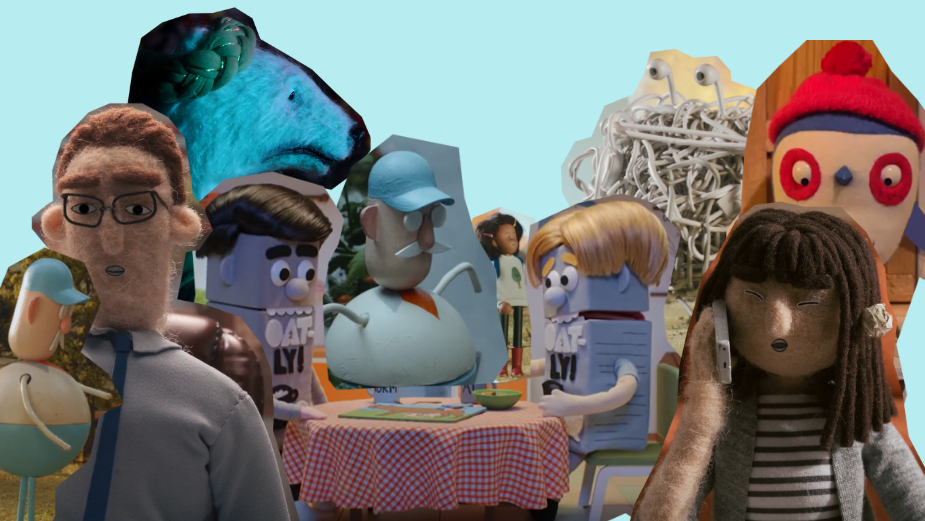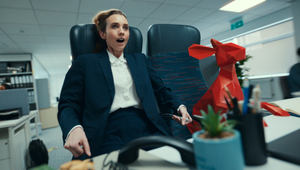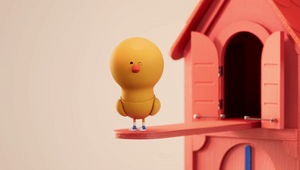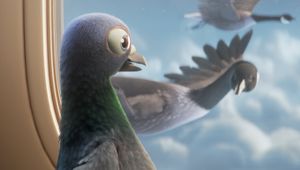
A Puppet Renaissance: Tech Innovation Pushing Us Back to Basics

Lately, things have gone quite tech-y. AI, prompts, real time animating… these are all great, but sometimes we need a healthy dollop of proper nostalgia and child-like wonder. And what’s more nostalgic than puppetry? Textile, clay and yarn galore, we all have had a favourite puppet or one we related to. From Elmo to Yoda, these hand-controlled characters have been practically inescapable in all sorts of production as early as the 5th century BCE across cultures and geographies. Despite this, they have remained relatively underestimated in brand communication and ‘serious’ film narratives.
In recent days, however, we’ve seen somewhat of a puppet renaissance, and not only in the children’s story realm. ‘The House’, an ominous Netflix series voiced by the likes of Mia Goth, Jarvis Cocker and Helena Bonham Carter brought puppets into the adult content realm and proved their effectiveness on multiple levels.
Meanwhile, on the totally opposite end of the emotional spectrum, gen z has fallen in love with Mona, the little green puppet from ‘Nanalan’’, more than 20 years after the show aired on Canadian television. Today, Mona has resurged as an ideal recipe for a series of wholesome memes on TikTok enjoyed by zoomers.

Behind the scenes on 'The House'
These examples are only the tip of the iceberg - on the commercial scale, Apple’s holiday film utilised beautifully crafted and animated felt dolls for a heart wrenching enemies-to-friends story, while Marmite chose two puppets and a catchy innuendo-filled song to nudge freshers to try the spread for the first time, and LNER has also recently introduced us to a new puppet mascot. So it seems that as they attract adults and children alike, these characters are also able to jump through genres, from horror to comedy and drama.
Siqi Song, Oscar and Annie-nominated director at Nexus, known for her tactile and thought-provoking work, grew up watching puppet shows in China. Particularly ‘Pi Ying Xi’, a shadow puppetry theatre play combined with music, opera and storytelling. “As a teenager, I fell in love with animation films, many of which are made with traditional puppetry techniques.” Naturally, her passion for puppets grew steadily over time until she started using puppets to make her own stop-motion films.

Siqi's miniature set on 'All In a Day's Work'
Similarly, Nexus’ Paloma Baeza, one of the directors behind ‘The House’, was always drawn to the craft involved in creating puppets, as well as the worlds they can inhabit. “There is something about them and the sets that taps into a nostalgia or atmosphere linked to doll houses, miniature things, imaginative spaces from childhood. The way that light can fall over textures, and inanimate objects coming to life, all have an immediate sense of magic.”
“My inner child is bursting to get out of me,” says double Cannes Grand Prix winner Johnny Kelly. He, too, sees the magic in miniatures: “Being able to do silly, thoughtful, dramatic and sad things with puppets awakens the excitement of a 8 to 11-year-old Johnny. 8 to 11-year-old Johnny is rubbish at career advice but has a knack for making me laugh.”
A ‘Chicken Run’ for Every New ‘Avatar’
Paloma believes that any story is suitable for puppets. “Sometimes it’s a tonal thing,” she says, reflecting on Johnny’s sentiment. “It could be anything from silliness to darkness.” To her, puppets coming back to the screen could be a “reaction to an increasingly technical world.” As she puts it, on a human level, people are naturally attracted to the tactility and analogue quality that dolls present, as a counterbalance to something computer-generated. “It’s comforting, playful and nostalgic.”
Johnny, however, believes that advertising has always been puppet-heavy - “It’s how Jim Henson started out!” But now, there are further opportunities to push puppetry in different unexpected directions beyond satire, and more towards ‘grown-up’ stories. “Or,” he adds, “ simply more insane.”
“My smoking-hot take is that stop motion and puppetry has felt a resurgence, both in commercials and in film, in the last 20 years because CG animation has rocked into awe-inspiring levels of sophistication,” he explains.
“The CG stuff is incredible, but it’s human nature to want to counter it with something that is kind of the opposite. The result is a yin/yang pendulum swing. For every ‘Avatar’ sequel, there will be a corresponding ‘Chicken Run’.”

Siqi's set on 'Sister'
Nexus’ Conor Finnegan also believes that, culturally, many people seem to be wanting to go back to the basics - be it freshly ground coffee beans, or courses offering wood whittling, sea swimming, or “primal screaming”. So, as we try to grow our own produce in big-city apartment buildings, we seem to increasingly enjoy what we used to as kids. It brings us to a pre-pandemic, pre-AI time where we weren’t as efficient, but probably a little more carefree. We want to see tangible things, things we can touch, and creations that mix with our real world.
Nexus’ Conor Finnegan also believes that, culturally, many people seem to be wanting to go back to the basics - be it freshly ground coffee beans, or courses offering wood whittling, sea swimming, or “primal screaming”. So, as we try to grow our own produce in big-city apartment buildings, we seem to increasingly enjoy what we used to as kids. It brings us to a pre-pandemic, pre-AI time where we weren’t as efficient, but probably a little more carefree. We want to see tangible things, things we can touch, and creations that mix with our real world.
For Conor, bringing everyday objects to life is the ultimate form of this experience. “There’s something so enjoyable about looking at an object and interpreting how it could come to life, how it could walk, talk, or gesture.” For example, Johnny’s short film ‘FERN’ tells the story of a puppeteered potted plant that falls obsessively in love with a woman (Monica Dolan), who is recovering from her husband’s death.


Shot from FERN by Johnny
“The upshot is a multitude of shots where fern fronds reach out with loving, and ultimately jealous, gestures,” laughs Johnny. “You only had to hold a little frond out and wobble it a bit and immediately our fern had character and menace. And you can roll the camera as long as you like, to try out different things. This is unthinkable with animation, where everything needs to be created from the ground up, and typically one frame at a time.”
These micro movements that bring to life inanimate objects present an incredible opportunity. People look for faces everywhere - cars, door knobs, the backs of chairs, or the fronts of houses. We want to see things become more like us, which inevitably leads us to love puppets. They don’t even need to have eyes or mouths, because we will naturally try to find them on the surface of any object.


On set of 'Poles Apart' by Paloma
Both Siqi and Paloma believe that the elements of the storyline affect whether puppets can be used within it, but believe that they can fit in almost anywhere. “Although choosing to use them to tell the story will definitely change how that story is executed in film language,” reminds Siqi. “A story that’s more character-driven and has less dynamics in time and space will be more suitable for puppet animation due to production limits.”
“Less Trickery” than CGI
There is more than nostalgia to these miniature characters, though. It’s not only their tangibility that makes them a preferred medium, but also the multitude of unique ways in which they trump fancy tech.
“Puppets also have a unique visual aesthetic that CGI cannot achieve,” explains Siqi. “Maybe it’s possible in today’s technology, but it involves a lot more work than simply using real materials.” According to her, puppetry’ creates a different scope of motions that CGI can’t, which often feels more organic than perfectly smooth animation. It is because both of these techniques have their own charm that they need to be carefully considered when the tonality and parameters of the projects are being laid down.
Paloma also believes that the medium always needs to be appropriate for the project: “Puppets are right for certain types of stories and CG or 2D, for others.” She explains that the right puppet should bring a certain charm, character and texture which will inevitably make the project unique.
“There’s something about them that is particularly warm, and potentially humorous when appropriate. When a puppet captures the right balance of charisma and design, they end up being hugely relatable because they physically exist.”
One can easily imagine a puppet in their own room, but it takes a bit more of an imaginative push to place an entire animated CG world in reality. This sense of intimacy is where puppets excel and you almost get the “benefit of a live performance,” as Johnny believes.

Siqi's sketching process on 'All In a Day's Work'
“When working on commercials, sometimes that energy can be useful to harness when it comes to approvals and moving forward. For example, a puppeteer might perform something amazing, getting a warm universal reaction from crew and clients as we watch playback on repeat. This energises the entire production.”
However, the two mediums can of course be used in conjunction. Johnny himself is no stranger to using CGI in his own puppet productions. “We’ll often add face replacement or lip-sync in post production, and this can often involve 3D animation and similar shenanigans. In the work I’m drawn to, the boundaries are blurred and I like to do the same - it’s unclear where the practical in-camera stuff ends and VFX arts begin.”


On set of Oatly by Conor
“Puppets have an inherent honesty,” adds Conor. “There’s less trickery and it’s often quite charming for the viewer to figure out how things are done. There are lots of factors that feed into something feeling like it should be puppeteered versus made in CGI, but I think a lot of it is to do with tone. Puppets can offer a level of comedy and inherent quirk that VFX can’t really match.”
Sculpts, Skeletons and Emotional Range
When compared to traditional computer animation, puppetry is a whole different ball game. Both are a craft to be studied and perfected, but one requires serious practical work with your hands - creating the thing from scratch and moving it yourself.
Conor has always been into “making things physically” so for him, puppetry brought together many of his pre-existing interests, and added lights and camera to the mix.
“It depends on the project but for me, it always starts with a 2D design. Sometimes a maquette or a clay model sculpture will be made for approval before being made into the final puppet with hair and costume being created and fitted,” he explains. Depending on the needed performance, there may be some rigging used to get certain movements or facial expressions too. “I’ve worked with puppets where we made multiple eyebrows for a certain character, each conveying a different emotion and we’d swap them out from shoot to shoot.”


Johnny's process stills on Chipotle
When Siqi designs a puppet character, she starts off with a focus on the story and character themselves - who is the character, what are their beliefs, why is she telling their story? From this, the practical aspects sometimes sort themselves out. “What kind of actions the puppet will do and how big the space they occupy is all are determined by its story. With all this information in mind, we decide on the size, the materials and the anatomy of the puppet.”
Similarly to Conor, Paloma explains that she starts with drawings of the character, to get to know their look better. This usually then gets translated into 3D by a sculptor, often in plasticine, so that proportions and sizes can be figured out and adjusted easily.
“If you’re doing stop motion, you’d then create a mould of this sculpt, called the maquette. This would be where you begin to plan and lay out the armature,” she explains. The armature is the skeleton of the puppet, with its needed joints. This can vary from very simple, to extremely complex with plenty of movement. “Once the skeleton is safely inside a body - usually some kind of foam - it can be covered in the flexible material of choice. Felt, wool, cloth… depending on your desired aesthetic.”
But when the character is an object from everyday life - such as a fern - things can get a bit more abstract when it comes to puppet ‘creation’ and design. Droga5 commissioned Johnny to direct a project for the Irish bank AIB, which told the story of a wheelie bag that comes to life, sneaks onto an aeroplane and travels the world.
“We needed to make a bag that emotes, so production designer Joe Fallover bought a load of travel bags and created a rigged, controllable character we called Casey,” Johnny explains. This required various rig points on the body of the case, which would allow the team to attach rods and manoeuvre Casey in a way that satisfied the drama of the script. “The retractable handle could slide up and down and that somehow had to convey her being sad, surprised, or absolutely furious. She had range!”

Still from AIB by Johnny
When it comes to ‘giving range’ to inanimate objects that don’t even look like people and haven’t got a face, design plays a key role too. Awareness of what you’ve been given is important - Johnny explains how the zipper needed to be positioned in the perfect ‘mouth’ spot. “When in doubt, I lean towards simplifying,” he says.
When it comes to ‘giving range’ to inanimate objects that don’t even look like people and haven’t got a face, design plays a key role too. Awareness of what you’ve been given is important - Johnny explains how the zipper needed to be positioned in the perfect ‘mouth’ spot. “When in doubt, I lean towards simplifying,” he says.
“It’s easy to stick googly eyes and Mickey Mouse gloves on a case, but often it can be a bit more interesting to see how little you can add before a character comes to life. You project more onto them yourself, and their personality comes across in how they perform.”
Similar simplicity is necessary when it comes to puppets’ voices. “If the performance is outlandish, the temptation is to go wacky with the voiceover. Often, the best inclination however is the opposite direction. You think of something like Becky and Joe’s ‘Don’t Hug Me I’m Scared’, where the vocal deliveries are often King Lear-serious,” says Johnny.

Stills of the 2D process behind BackMarket
Conor, too, believes that going into the ‘cutesy’ or overly sweet direction might be a mistake and might even shorten the emotional range of a puppet. “I much prefer my puppets to sound like real people,” he says. “Most of it comes down to tone and talent. Often when an actor sees a character design of a small bird, they’ll pitch their voice up and start sounding like Mickey Mouse. So, often it’s a case of actually not showing the actors the design and speaking to them more about the personality behind the character, rather than the appearance.”
Conor, too, believes that going into the ‘cutesy’ or overly sweet direction might be a mistake and might even shorten the emotional range of a puppet. “I much prefer my puppets to sound like real people,” he says. “Most of it comes down to tone and talent. Often when an actor sees a character design of a small bird, they’ll pitch their voice up and start sounding like Mickey Mouse. So, often it’s a case of actually not showing the actors the design and speaking to them more about the personality behind the character, rather than the appearance.”
When all of this comes together, the hardest part commences - actual puppeteering on set. Puppet directors are used to having to ask themselves questions such as ‘How many puppeteers will a character need?’, ‘Will they all fit around the puppet?’, ‘Could the puppet be larger so the puppeteers don’t need to invade each others’ space?’ etc.
There is a lot of figuring out to do, and often it involves lots of push and pull between puppeteer, puppet fabricator and set builder, says Johnny. The post production team, too, needs to be involved from the start.
“Puppeteers inevitably have the hardest job on set,” adds Conor. “They go for hours, cramped under a set, sometimes dozens of them in very close proximity. It’s amazing to see them work as a team - one might do the arms of the character, while another controls the head, and another does the mouth. It’s insanely complicated, but they somehow come into unison through the performance, and when you look at it on camera you wouldn't even know they’re there.”
Is Everybody Fit for Puppetry?
Advertising has been playing with puppets for a long time but what does it take for a brand to take the leap and make a mascot, or engage in a sweet one-off puppeteered story? According to Siqi, any brand has the potential to use puppets, as long as it finds the right storyline.
This becomes clear, especially when we look at the range of brands that have engaged in puppetry and animatronics. Sustainable deodorant brand Wild used a massive, dirty-talking polar bear that tries to help his girlfriend who has a ‘climate change kink’, if anything else isn’t proof enough.
Johnny believes that puppets do require a bit of a leap for clients, but not necessarily for storytelling reasons. “With animation you typically see what you are getting in gradually improving increments, whereas you need to wait till shoot day to see what on earth the puppeteered performance is. The required patience can make some clients nervous, but this first shoot day is usually a very exciting moment.”

Still from Dorset Cereals by Johnny
A big factor in whether a brand tries puppetry is also what story they want to tell. For Johnny, the obvious choices are silly or absolutely unhinged, which is puppetry’s superpower.
He himself has worked with clients whose first choice wouldn’t usually be puppetry, such as Back Market, a global marketplace for refurbished tech. They tasked him with creating a cable monster that could spew out devices - phones, tablets, etc. - representative of “certain tech giants selling you on frequent upgrades when a secondhand jobbie would do just fine.”


Shot from BackMarket by Johnny
Conor, on the other hand, has worked with Android on ‘Be Together, Not The Same’, a film on a huge scale with three main characters - a sheet of paper, a pair of real scissors and a small stone brought to life. Shot in Watford, which was supposed to look like a neighbourhood in California (and it snowed the first day on set), the project was a real curveball in Android’s creative output. “It was so ambitious but we somehow pulled it off. The film aired during the Oscars and was really well received, which was a nice plus,” he says.
As Johnny puts it, puppetry can often be a trojan horse for deeper or darker subject matter. And it seems that audiences will love them either way, so they might just be the perfect Venn diagram overlap for children, adults, comedy-lovers and those who take themselves too seriously. Or people that like very, very disturbing things.
“Usually,” says Conor, “those brands who leap into puppetry are those that want to convey integrity or real-ness. It might be easier to list brands that puppetry would be used less for, like car or computer brands. But, there’s always an opportunity to buck the trend. I for one would love to direct a car ad with puppets!”















